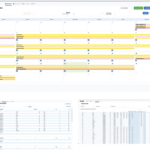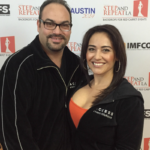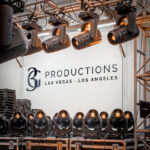Headed up these days by industry veteran Chuck Young, the Nashville-based video house originally grew out of the country music scene, and since its inception has expanded its client list to include the likes of Brad Paisley, Jake Owen, and One Republic. Even after working with some of the biggest names in the music industry and winning the Parnelli Video Company of the Year award in 2014, Young remains humble about the company and their success.
 A Full Service “Boutique”
A Full Service “Boutique”
“We really view ourselves as a boutique video company,” he tells me on a warm July day at their Madison, TN warehouse. “We are a full-service video company, and we’re not trying to be everything to everybody. If you hire us, we’re all in — we’ll assist from beginning to end. If that means buying a seat on an airplane because a piece of gear has gone down, that’s what we’ll do.”
From their headquarters, they provide LED video solutions, top-of-the-line HD video cameras, switchers, CCUs, media servers and playback equipment. Although intent on keeping their gaze steady on video, Chuck admits that the line between lighting and video has grown increasingly thin in recent years with the variety of products on the market that muddy the boundary. “It’s hard.” he laughs, “It’s a moving line, honestly a very blurred line, and we get that. And in terms of control, so much of the video that we used to do is now fired by the lighting desk, but we can do it either way.”
 From the time a client comes to Moo in search of video solutions, the full force and creative genius of the company stands behind, ready to assist. “When someone hires us, we’ll be as involved as they want us to be. If it’s a young band, who really has no reference point for their design and content feel, we will absolutely help them. We can design the whole thing for them, create content, come up with something that they can afford, and make them look the best they possibly can within the budget they have.” With a full stock of Barco, digiLED and other video gear, the creative and technical staff at Moo can not only design and execute tours and events small and large, but provide an experienced and professional staff for any kind of production.
From the time a client comes to Moo in search of video solutions, the full force and creative genius of the company stands behind, ready to assist. “When someone hires us, we’ll be as involved as they want us to be. If it’s a young band, who really has no reference point for their design and content feel, we will absolutely help them. We can design the whole thing for them, create content, come up with something that they can afford, and make them look the best they possibly can within the budget they have.” With a full stock of Barco, digiLED and other video gear, the creative and technical staff at Moo can not only design and execute tours and events small and large, but provide an experienced and professional staff for any kind of production.
One of those people is Andrew Burnett, logistics manager. “I act as the go-between between the designers, artists, and management.” Andrew explains. “Tim [chief systems engineer] and I work hand-in-hand to figure out how to take a design from paper to deployment. We take everything into consideration — what kind of pixel pitch the tour is looking for, what applications they’re looking to use their LED for — for instance, whether it’s for I-Mag or for graphics. We also look at more practical considerations of weight and dimensions. How many crew members will be required to put it up, as well as time factors. We always do our best to come up with something reasonable that meets everybody’s needs.”
 Getting all those pieces to work together is often one of the most challenging pieces of the puzzle, as chief systems engineer Tim Monnig knows all too well. “I come from a creative background, initially coming into the company as a video editor. I had a good sense of visuals and movements, and when I wasn’t on tour, I was building content, and I eventually grew into the role of helping to integrate the technological and creative elements into a cohesive whole.” When it comes to building systems, Monnig’s goals are defined by some ironclad guiding principles. “I work backward. I don’t like to rebuild the system three times, so we design things with overhead in case gear gets added later. We’re also incredibly obsessive about backup systems — we build redundancies into every step of the system. For example, in one of the rigs we’re prepping now, we have four separate points where gear could completely fail before we got to a point where there wouldn’t be a show. And even in the event of a total catastrophic media server failure, we would still be able to play back content.”
Getting all those pieces to work together is often one of the most challenging pieces of the puzzle, as chief systems engineer Tim Monnig knows all too well. “I come from a creative background, initially coming into the company as a video editor. I had a good sense of visuals and movements, and when I wasn’t on tour, I was building content, and I eventually grew into the role of helping to integrate the technological and creative elements into a cohesive whole.” When it comes to building systems, Monnig’s goals are defined by some ironclad guiding principles. “I work backward. I don’t like to rebuild the system three times, so we design things with overhead in case gear gets added later. We’re also incredibly obsessive about backup systems — we build redundancies into every step of the system. For example, in one of the rigs we’re prepping now, we have four separate points where gear could completely fail before we got to a point where there wouldn’t be a show. And even in the event of a total catastrophic media server failure, we would still be able to play back content.”
Moo’s devotion to serviceability was clearly illustrated a few years ago during a DVD shoot for Jason Aldean’s stadium show. “We looked down, and the UPS in the server rack completely died.” Andrew recollects, laughing. “Every server in the entire rack went dark at the same instant. Of course, now we had to look for alternative sources of power, and we didn’t want to trust anything else in the rack, so we ended up bringing over distros and unplugging everything that had been getting power from the UPS. And in the space of about five minutes, we tore the rack down to its constituent pieces to provide alternate power for everything, started the show, and everything was fine for the remainder of the night. We knew our rig well enough to know what we could trust and couldn’t trust, which led to the best possible outcome for that situation.”
When Chuck talks about Moo’s customer service, he does so with the gravity of someone who fully understands the immense pressures of live production. “We all know that in our business, failure is unacceptable, especially if it impacts the show. Even if you have a lot of great history with a client, it doesn’t take but a few failures to wipe all that out. Good will is fleeting in this industry. It’s very important that when something goes wrong, we respond appropriately and quickly.” As the people fielding any support request that comes in, Andrew and Tim agree wholeheartedly. “Tim and I are unofficially on-call twenty-four seven, and we both take a share of the calls. The tours know that they can call us at any given point.”
Of course, not every production has Aldean’s budget, but Moo’s commitment to quality crosses budgetary boundaries, as Burnett explained. “We’re very proud of our devotion to production values. When we have a client on a tighter budget, we’re not going to neglect to send out redundancies and backups just because the budget is smaller. First and foremost, we value the show quality. We’ll work with the client to find a solution that works. No matter what, redundancy is baked into all of our systems that we send out.”
On the Horizon
So what new technology gets Moo excited these days? “The thing we talk about a lot around here is laser projection. Projection is making a huge comeback, and all the tour specs we’re looking at for this fall and next year have some sort of projection in them,” Young says, talking about some of the challenges of large projectors on the road. “We’ve dealt with a lot of designs that incorporated very large projectors, without designers understanding the impact that sort of power has in terms of thermal management. With 30k and 40K projectors, you can’t handle them hot. And so you end up having to wait an hour and a half or two hours for the lamp to cool before you can even pack the projector up and load it out. And that’s not practical for touring.” While the laser projection technology still isn’t viable as a one-to-one replacement for arc-lamp projectors yet, they’re looking forward to the future. “There’s still a lot of things to work out, but what we’ve seen the last few years is very promising.” he says. “You get a stable image, no color drift, better saturation, and of course, no enormous arc lamp to deal with. It’s exciting.”
The newest projectors or highest-resolution video screens mean nothing however, without great-looking content being sent to them. So for content creation, Moo frequently works hand-in-hand with their sister company Moo Creative. “They can do some incredible things.” says Chuck, referring to the creative minds at work across town. “They are really great at capturing things, whether it’s a traditional medium, high-speed video, or anything else.” With a full host of software and hardware, the Moo Creative team has worked on a host of corporate commercials, music videos, and of course, video content for touring acts. One of their favorite creative projects was the development and execution of the “hologram” effects used in the live shows of several top performers, including Brad Paisley. “We used to do it with projection and mirrors. But now we have 4mm LED that looks so real, it’s unbelievable. So we made a six-foot section of it that fit down into a riser, and all night long the band plays around it. When it comes time for the gag, the stage goes dark, the riser pops up, and all of a sudden the holographic performer is upstage singing next to the live performer. Fans are just blown away by the effect.” Moo also handles all of the on-ice projection mapping for the Nashville Predators, the NHL hockey team, which Young — a season ticket holder with a wall of Predators memorabilia — is especially proud of.
Moo U
Another large part of Moo’s ethos is the development of their workforce. “One thing we do at least once a year, and sometimes several times a year, is something we call Moo U, a continuing education program that we do in-house,” says Young. “We tap into all the manufacturers we have good relationships with and say ‘Send us your chief engineers and trainers’. Then we schedule a few weeks during the slow points of the year to train people on the latest gear and technology.” Moo is also keen to cover the basics, to help their workforce be competent not only on the latest whiz-bang tech, but also the basic skills that the company wants each and every one of their touring personnel to posses. “We’ll have directors classes, we’ll have media server classes, and we’ll have camera classes.”
Young also speaks with solemnity about rigging and power safety. “This past year, we had a lot of new employees come in, so we had a ‘basics day’, where we brought riggers and electricians in. When you have new people come in who don’t know the fundamentals, you need to make sure they’re working safely. You have to give them the knowledge.” This outlook regarding building their team’s collective knowledge through training and workshops is at the very core of the Moo ideology. “Scott Scovill’s philosophy is that it’s way easier to teach a good person how to do video than it is to teach someone to be a good person. So we try to find good people who have the fire and desire to learn, and develop their skillset.” Moo certainly hasn’t shied away from engaging the community at large with this philosophy either, having been a sponsor of Chris Lisle’s Touring Career Workshop since the very beginning.
And where does the company see themselves in the coming years? “We’re splitting at the seams, so our long-term plan is to have a rehearsal space and double our square footage. We also want to be able to offer a visualizer space for our clients to come in and do their preproduction here.” He also speaks to their continuing commitment to their workforce. “Our whole business model is about having a great bunch of people together with a common interest. Five or however many years from now, we just want to still be in the game, become that much tighter and better at what we do. We know there’s a lot of homework that comes with our commitment to excellence. Just because you’ve been on a gig for a season or two doesn’t mean you know everything, and the way technology changes, if you’re not moving forward, you’re moving backward. Our reputation is the most important asset we have, and you get that reputation from doing what you say you’ll do.”
“We don’t want to be the biggest.” Young concludes with a grin. “We just want to be the best.”
Corporate Snapshot:
Moo TV
Founder/Owner/CEO: Scott Scovill
General Manager: Chuck Young
Chief Systems Engineer: Tim Monnig
Logistics Manager: Andrew Burnett
Headquarters: Madison, TN (Nashville area)
Services: LED video rentals, HD video cameras, more.
Affiliated with: Moo Creative (video content)
On the Horizon: Laser projection, bigger home base with rehearsal space.
More Info: www.mootv.com


